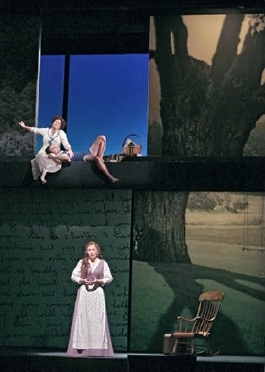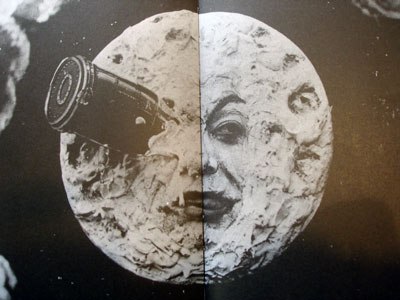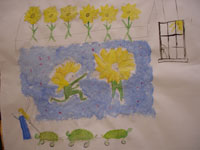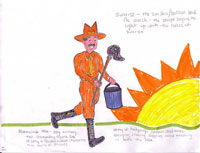Tonight’s workshop was as exciting as last week. Attending were Melissa, Laura, Carol Lee, and Dale.
We shared our visuals for Sun & Moon Circus: Marc’s pajamaed Tiger looking at angels rolling the Sun & Moon into position; Melissa’s angel ringmaster; Carol Lee’s painted umbrella (and pencil sketches of various characters); and Dale’s fuzzy pastel drawing of the King of Cats and the “fitful flashing lights.”
Everyone had had more ideas during the week, and so we added those, and we riffed on the visuals: Sun & Moon as a two-sided puppet; the three sunflowers as a kind of curtain, parting to reveal the circus; angels with umbrellas on tightropes; clowns using the planets as balloons, bopping them up into the air; stars as tumblers; pulling the whole circus into slow motion at the final rallentando, then vanishing, with a comet sweeping across the front of the stage as the final image.
We discussed extending the circus music so that we have more than thirteen seconds of circus: pre-repeat the circus waltz, then have the chorus sing.
Then we moved on to Man in the Marmalade Hat. It clearly divides into two sections. We seized on the line “Winter is over, my loves” and made the first half (and probably the entire work up to that point) in the winter, with snow drifts sprouting green grass and flowers appearing everywhere in the second half.
Everyone saw his entrance as a parade, of course: standards, pennants, marching percussion, attendants (ice sprites in the first entrance); mop as baton. For the keepers/sleepers chorus, we thought the regular gang (tiger, king of cats, etc.) could be the dance squad. For the repeat, we posited a horde of five-year-olds in hedgehog costumes. They would come rolling out of the walls of the Inn, like clowns from a clown car.
We finished up with Two Sunflowers Move Into the Yellow Room, and we had some silly moments: the sunflowers as two old ladies, with traveling bags; the sunflowers with long dresses, from which emerge/spurt the topaz tortoises.
But we also had some interesting motifs: a troupe of traveling sunflowers, which we’ve seen between numbers or even during numbers before this one, and begin with the troupe arriving on another journey, stopping facing upstage. The Two Sunflowers turn (with their traveling bags packed) and begin their duet as they move forward.
Again, we have to extend the piece: it’s 1:01 total. Again, easy to solve. We just repeat and expand the waltz after the chorus, then repeat the chorus bit. Finally the traveling troupe continues its journey while the Two Sunflowers settle in. Lots o’ ideas for topaz tortoises.
Assignment: visuals for Man in the Marmalade Hat and Two Sunflowers, and play with some choreography for the hedgehogs.
Soon it will be time for us to stop drawing and writing, and start moving and building.




